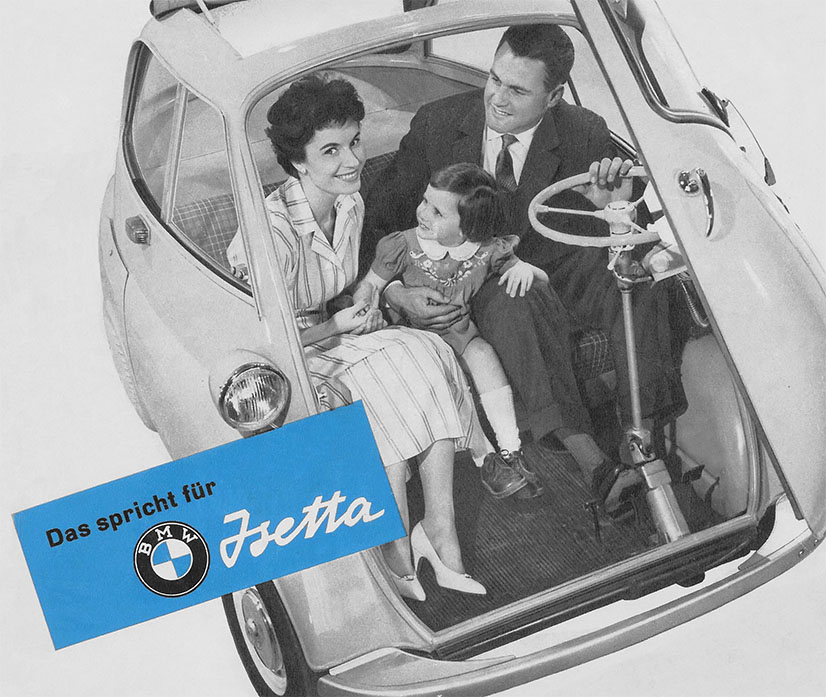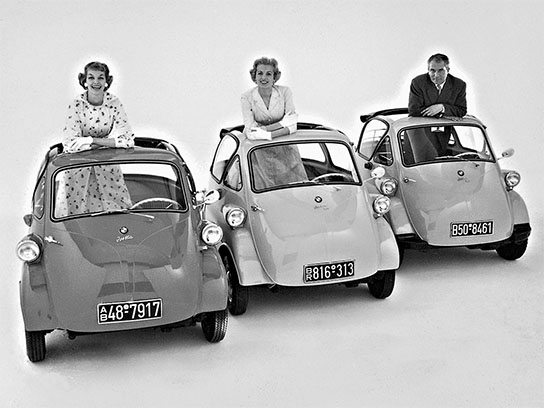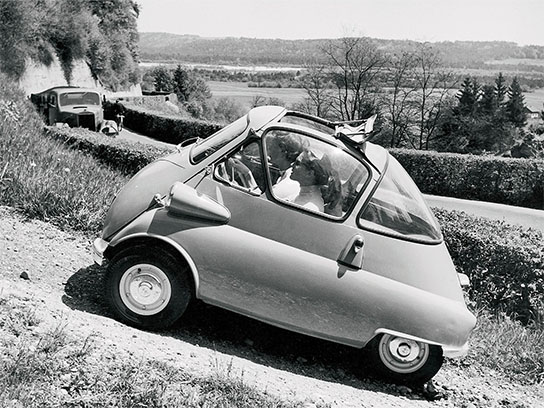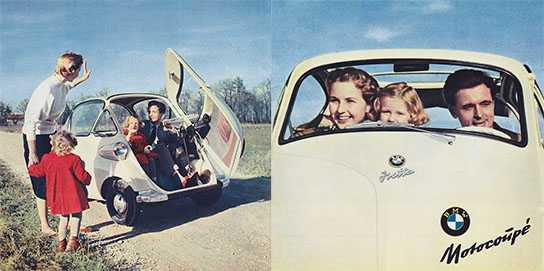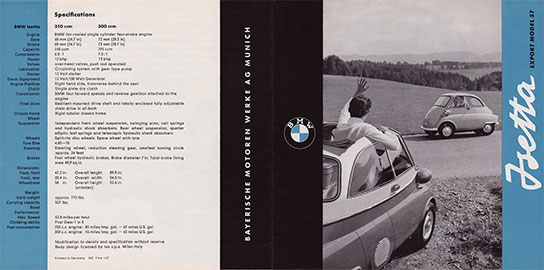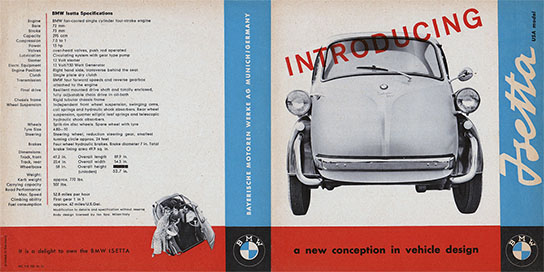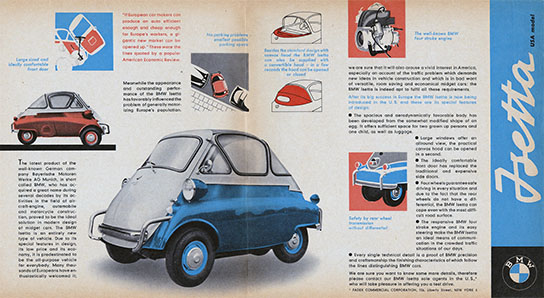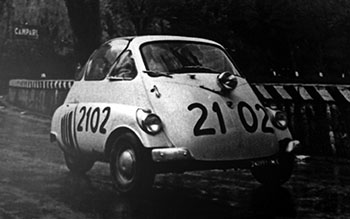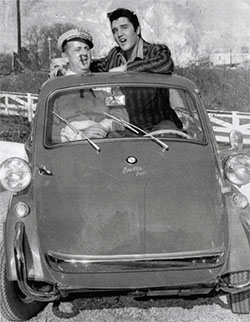96
The Isetta
After the War West Germany rebuilt its’ infrastructure and revitalized its’ economy with a breathtaking speed that no one could have predicted. The reconstruction was so stunning that the Germans gave it a name - the Wirtschaftswunder. The 2-color image above, from the cover of the ca.1956 Isetta brochure, captures the spirit of the late 1950s and the Wirtschaftswunder perhaps as well as anything else. Here are a few more promotional images from 1956:
Promotional photos, 1956
After the management of the aircraft engine manufacturer Rapp Motorenwerke forced out its founder Karl Rapp in 1917, it renamed the company Bayerische Motoren Werke AG (Bavarian Motor Works, or as you know it today, BMW). In addition to aircraft engines, BMW began manufacturing motorcycles in 1921 and automobiles in 1928.
After WWII the company was in shambles. The East German plants were annexed by the Soviets and the Munich plant was essentially rubble. Because of their aircraft, jet and rocket engine production during the war the Allies imposed a three-year ban on manufacturing. The company resorted to making pots, pans, and bicycles.
In 1949 they resumed motorcycle production and in 1951 they introduced the 501 “Barockenge,” their first car in 11 years. There could have hardly been a worse choice. The 501, a large V-8 luxury sedan was completely out of reach of post-war Germans and fell well short of sales expectations. The company was barely surviving and became a prime candidate for a takeover.
Then came the Isetta.
The Italian company Iso SpA was best known for commercial refrigerators. After the War the owner Renzo Rivolta switched direction and began producing scooters and small 3-wheeled trucks. By 1952 the engineers Ermenegildo Preti and Pierluigi Raggi had designed a small car based on a scooter engine and named it the Isetta (a diminutive of little ISO). It debuted at the 1952 Salone dell’automobile di Torino and won the top three spots in the economy class at the 1954 Mille Miglia.1
Ironically, Iso only built 1000 Isettas. Instead Rivolta licensed the design to whom ever he could - Velam in France, Romi in Brazil, and most importantly BMW in Germany.
Isetta 250 brochure, 1956
BMW licensed the design in Oct 1954 and over the next eight months almost completely re-engineered the car (because that’s what Germans do). They showed prototypes to the press in Mar 1955 and by the end of the year had sold almost 10,000.
Isetta 250/300 brochure, 1956, Courtesy BZ’s Isetta Site
The Isetta was everything the 501 wasn’t. It was small (2.28 × 1.38 m),2 inexpensive (2,550 DM, or 20% of the price of a 501) and relatively cheap to operate (50–70 mpg or about 1 cent/mi). It was exactly what the Germans wanted at the time and soon BMW couldn’t keep up with demand. In 1956 they introduced the Isetta 300 and in 1957 the even more bizarre two-door four-seat Isetta 600. Between 1955–62 BMW sold more than 160,000 of the “das rollende Ei.”
Isetta 300, Eagle Comics, 1957, Courtesy BZ’s Isetta Site
Although the Isetta seemed to be a uniquely unqualified candidate for export, the legendary Max Hoffman managed to sell more than 12,000 of them in the US.3
Isetta Export Model, 1957, Courtesy BZ’s Isetta Site
Isetta 300, USA Model, 1957, Courtesy BZ’s Isetta Site
By the 1960s “bubble cars” such as the Isetta had largely been replaced by the more conventional BMC Mini, Austin A35, Fiat 500 and VW Beetle. But by then it didn’t matter, the Isetta had served its’ purpose; it tided the company through difficult economic times and formed the basis of their next successful car - the 1960 BMW 700:
700 Convertible, ca.1961. From John LLoyd’s Flickr stream
1. Of the seven Isettas in the race, five finished; a remarkable acheivement. To put this in some perspective, however, the winning entry, the Scuderia Lancia D24 driven by Alberto Ascari, finished the 1597 km course in 11:26.10. The Isettas finished in 176–179th place, with the best time by Mario Cipolla/L. Brioschi at 22:04.52. Here is a photo of Cipolla’s car:
2. For comparison the 2011 Smart FourTwo is 2.69(l) × 1.56(w) × 1.54m(h), i.e., larger in every dimension then the Isetta.
3. True Story: Your humble narrator’s aunt had a baby blue Isetta, purchased by her Dad, to tool around the campus of Indiana University ca.1960. I remember asking her once how many college students could fit in the car - like two, maybe three? She said, no, we managed alot more than that! The most famous American owner of an Isetta, however, was not my Aunt but Elvis who bought a red 300 as a Christmas gift for Col. Parker. This publicity photo is from 21 Dec 1957:
26 Jun 2011 ‧ Design
